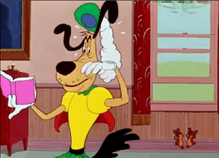A Ham in a Role
A Ham in a Role is a 1949 Warner Bros. Looney Tunes short starring the Goofy Gophers along with an unnamed dog who is based on stage/film actor John Barrymore.[2] The cartoon was planned by Arthur Davis, but was finished and directed by Robert McKimson. It was released by Warner Bros. Pictures on December 31, 1949,[3][4] but some sources list the release date as December 13, 1949.[5] The cartoon draws heavily from the works of William Shakespeare, with its gags relying on literal interpretations of lines from Hamlet, Julius Caesar, Richard III, and Romeo and Juliet.
| A Ham in a Role | |
|---|---|
 The Goofy Gophers begin to get their revenge at their nemesis by "lending him ears". | |
| Directed by | Arthur Davis (planned, uncredited)[1] Robert McKimson (finished, credited) |
| Produced by | Edward Selzer (uncredited) |
| Story by | Sid Marcus |
| Starring | Mel Blanc Stan Freberg (uncredited) |
| Music by | Carl Stalling |
| Animation by | Charles McKimson Phil DeLara J.C. Meléndez Emery Hawkins Additional animation: Pete Burness (uncr.)[1] |
| Layouts by | Cornett Wood |
| Backgrounds by | Richard H. Thomas |
| Color process | Technicolor |
Production company | |
| Distributed by | Warner Bros. Pictures The Vitaphone Corporation |
Release date | December 31, 1949 |
Running time | 6 minutes 47 seconds |
| Language | English |
A Ham in a Role would be the last cartoon in the Golden Age of American Animation to star the dog that had opposed the Gophers in their first two appearances (he would be recycled for a single short in the 1990s in the World Premiere Toons series).
Plot
An anthropomorphic dog is tired of appearing in cartoons and goes home to study the works of Shakespeare. Upon arriving back home, the dog finds that his home has been invaded by gophers. Unfazed, the dog then begins reading Hamlet. Upon discovering the Goofy Gophers sleeping in the book, he throws the book out the window.
The Goofy Gophers then decide to get back at the dog by literally interpreting lines from Shakespeare's works, including "lending him ears", by rolling a curtain up to annoy him, tormenting him with flames (to his foot), dousing him with "the joy of life" (by dumping a tub of water into the dog), dumping limburger cheese as the dog utters the "that which we call a rose by any other name" line while holding a rose, imitating the exhumed Yorick in a dance (making the dog appear like a Shakespearean coward), using magnets on the floor and ceiling to toss and carry the dog around the room (in armor), with the coup de grâce coming about when the Gophers use a horse to kick the dog out of his house, after he says "A horse, a horse, my kingdom for a horse!" and back to the studio, where the dog decides to finish what he started.
Notes
This cartoon was originally issued as a Looney Tunes cartoon with the Looney Tunes music. When it was re-issued in 1959, the cartoon was re-issued with Merrie Melodies credits, but retained the Looney Tunes music.
Arthur Davis was originally slated to direct the short, however the short was left unfinished due to the dissolving of his unit during the shorts production (voice recording took place in November 1947, the same time Davis’ unit was in the process of being dissolved). Bob McKimson was able to finish the short by 1949, as well as inheriting two of Davis’ animators, Bill Meléndez and Emery Hawkins.
References to Shakespeare
(By Order of Appearance and Character Role)
Hamlet Act 3, Scene 1 (Hamlet)
Julius Caesar Act 3, Scene 2 (Marc Antony)
Hamlet Act 1, Scene 5 (Ghost)
Romeo and Juliet Act 2, Scene 2 (Juliet)
Hamlet Act 5, Scene 1 (Hamlet, about Yorick)
Hamlet Act 1, Scene 5 (Hamlet, to Ghost)
Julius Caesar Act 2, Scene 2 (Julius Caesar)
Richard III Act 5, Scene 3 (Last lines of the scene of which Richard is preparing his soldiers for battle.)
Richard III Act 5, Scene 4 (Catesby and Richard III)
Romeo and Juliet Act 2, Scene 2 (Juliet)
Hamlet Act 3, Scene 1 (Hamlet, with a comedic twist)
Availability
- DVD - Looney Tunes Golden Collection: Volume 6, Disc 1 (with original cards)
- Blu-ray - Looney Tunes Platinum Collection: Volume 3, Disc 1
- DVD - My Dream Is Yours
References
- http://cartoonresearch.com/index.php/robert-mckimsons-a-ham-in-a-role/
- Lenburg, Jeff (1999). The Encyclopedia of Animated Cartoons. Checkmark Books. pp. 87–88. ISBN 0-8160-3831-7. Retrieved 6 June 2020.
- Beck, Jerry; Friedwald, Will (1989). Looney Tunes and Merrie Melodies: A Complete Illustrated Guide to the Warner Bros. Cartoons. New York, NY: Henry Holt and Company. ISBN 0-8050-0894-2.
- Maltin, Leonard. Of Mice And Magic: A History Of American Animated Cartoons (Revised ed.). New York, NY: Plume. ISBN 0-452-25993-2.
- Schneider, Steve (1988). That's All Folks!: The Art of Warner Bros. Animation. New York, NY: Henry Holt and Company. ISBN 978-0805008890.